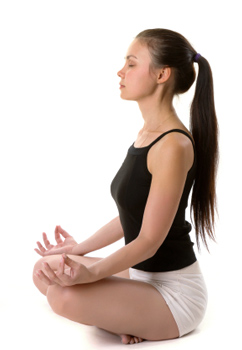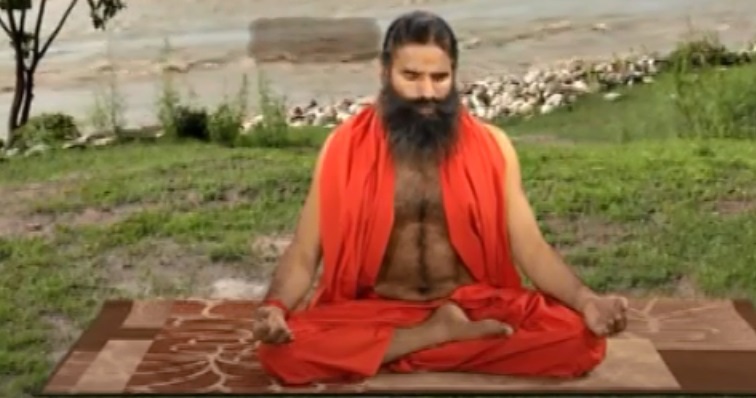 The word “Ujjayi Pranayama” made from the Sanskrit prefix “ud” (उद्) and “Ji” (जि): “ujji” (उज्जि), Ujjayi (उज्जायी), which means “Victory”, “one who is victorious”. Thus the Ujjayi breath means “victorious breath”. In this breathing exercise, the process of Inhalation (breath in) and exhalation (breathe out) are both done through the nostrils. During the process of Inhalation (breath in or Poorak) the “ocean-like sound” is formed by moving the glottis as air passes in and out.
The word “Ujjayi Pranayama” made from the Sanskrit prefix “ud” (उद्) and “Ji” (जि): “ujji” (उज्जि), Ujjayi (उज्जायी), which means “Victory”, “one who is victorious”. Thus the Ujjayi breath means “victorious breath”. In this breathing exercise, the process of Inhalation (breath in) and exhalation (breathe out) are both done through the nostrils. During the process of Inhalation (breath in or Poorak) the “ocean-like sound” is formed by moving the glottis as air passes in and out.
The sound is produced because of the friction of air within the throat; a typical sound like the ocean is made. (The sound is completely different from the sound emitted from the larynx) thence, the Pranayama is termed as Ujjayi Pranayama. By this, it is also called “Sound Breath” or “Ocean sound breath”.
As the throat passage is narrowed thus, too, is that the airway, the passage of air through that creates a “rushing” sound. The length and speed of the breath are controlled by the diaphragm, the strengthening of that is, in part, and the aim of Ujjayi Pranayama. The inhalations and exhalations area unit equal in a period, and the area unit controlled in a very manner that causes no distress to the professional person. Ujjayi Pranayama helps to equalize and calming the breath that will increase the action of oxygenation and build internal body heat.
In Ancient days some Yog Rishi’s mentioned that by Ujjayi Pranayama Yogis can melt the snow.
Navigator
How to Perform Ujjayi Pranayama
- Sit in any meditative pose like Padmasana (Lotus pose) with eye closed and try to keep your spine erect.
- Take a long, deep breath slowly from both the nostril (inhale or breath in).
- While breath in trying to contract the throat and feel the touch of air in your throat.
- Remember one thing air should not touch inside the nose.
- As air touches the throat a peculiar sound is produced.
- Enable the breath to be light and relaxed as you slightly contract the rear of your throat, making a gentle hissing sound as you inhale and out. The sound isn’t forced; however, it ought to be loud enough so if somebody came near you they’d hear it.
- Now breathe out by closing your right nostril and exhale from the left nostril. Try to produce the sound ‘HHHHHAAAA’ while exhaling.
Ujjayi Pranayama other technique
- The inhalation and exhalation ought to be gentle and controlled. Inhale slowly and deeply through the nostril and retain the breath within with full awareness as long as simply doable. This is often called Antar kumbhaka (inner retention).
- After it, exhale slowly and deeply as long as well with full awareness. When full exhalation, retain the breath outside for an awfully comfy amount of your time. This is often Bahya kumbhaka (outer retention). Before, obtaining any strain, begin inhalation once more.
- Remember, don’t take any strain once acting kumbhaka (retention), one or 2 seconds is decent initially. Step by step increasing the length because the technique is perfect.
- This is one spherical of Ujjayi pranayama with retention observe its twelve rounds initially and step by step increase it to ten minutes.
There is one another technique for Ujjayi Pranayama. In the third technique apply Bandha’s with breath-holding. First of all attempt Ujjayi pranayama in a simple way then try with kumbhaka and at last if you are master in doing Ujjayi with Kumbhaka then go for Bandha’s in Ujjayi pranayama.
As beginners Perform Ujjayi pranayama 3 to 5 times. Once you are used to it then increases the time as per your ability.
Benefits of Ujjayi Pranayama
- It boosts the focusing power of the mind.
- The body becomes healthy, strong and lustrous.
- It generates internal heat.
- Gives a positive attitude.
- Very helpful in clearing blocked arteries regulates cholesterol.
- Helps in cataracts and sinus problems, Rheumatism and migraine also.
- It lowers the risk of heart attacks.
- Prevents thyroid problems and makes voice sweet and melodious.
- Best for those people who are in the singing profession.
- Beneficial in chronic cold, cough, indigestion, liver problems, dysentery, fever and other diseases.
- Best for arousing Kundalini, meditation.
- Increases the concentration power.
- Improve lisping problems in children.
- Very helpful in Asthma problems and other respiratory diseases.
Best time for doing Ujjayi pranayama
- Early in the morning or evening time.
- Before doing meditation.
- Do Ujjayi Pranayama for 3 to 5 times.
Physiological Importance of Ujjayi Pranayama
Breathing through the nose humidifies the indrawn air, tempers it and removes mud particles. Exploitation Ujjayi Pranayama permits you to breathe clean air. The murmuring Ujjayi pranayama sound causes the bronchi to vibrate subtly, activating the ciliate epithelial tissue. Mud particles will be far from the lungs during this method. Throughout traditional respiratory, the pressure on the bronchi throughout exhalation is sort of modesty. Ujjayi Pranayama maintains steady pressure within the bronchi, even throughout the exhalation. This counteracts the collapsing of the smaller bronchi, permitting the exhalation to be swollen and also the quantity of residual air within the lungs to be reduced. This respiratory technique is very helpful for those that suffer from chronic hindering respiratory organ conditions or bronchial asthma.
what is Pranayama
Precautions for Ujjayi Pranayama
- Those people who are suffering from heart diseases & high blood pressure not combine Bandha and breathe retention in Ujjayi Pranayama.
- Don’t tighten your throat during Ujjayi pranayama.
- Don’t do Ujjayi pranayama with strain. According to your ability hold the breath.
- Do Pranayama systematically one by one on an empty stomach.
- Take the help of Yoga teacher while doing Asanas and pranayama.
Other Breathing Techniques
- Bhastrika Pranayama
- Kapalbhati Pranayama
- Bahya Pranayama
- Anulom Vilom Pranayama
- Nadi Shodhana Pranayama (Alternate Nostril Breathing)
- Bhramari Pranayama
- Udgeeth – (chanting the word Om)
- Pranav Pranayama
- Sheetkari Pranayama {Hissing Breath}-Steps And Benefits
- Sheetali Pranayama {Cooling Breath}-Steps And Benefits
- Chandra Bhedana Pranayama (Left Nostril Breathing)-Steps And Benefits
- Surya Bhedana Pranayama (Right Nostril Breathing)-Steps And Benefits


where do you find the research to back up the claims of the benefits? I am curious if there are studies on this information? I would love to read more
benefits on the daily basis of practice, if you really want to know more about this then read the patanjali yog sutra.
I am a teacher by profession, and when I speak continuously for an hour, swelling comes in vocal cord. Kindly tell me that ujayi will be beneficial or not.. m suffering from thyroid also..
Dear Neelam
do Brahmari Pranayama , also asanas like Setu bandhasana, Sarvangasana( nto during monthly period)
also take lime and honey ( hot) in the morning
as a teacher throat isseus are common( my daughter is also a teacher)
@Neelam, Do kapalbhati and Ujjayi pranayama 10 to 15 minutes daily. These two pranayama are best for your swelling as well as thyroid problem. Along with do Sarvangasana. Boil ginger, tulsi, black pepper and drink it daily.Gargle helps you in swelling problem. Thnx for your comment; may god bless you.
I have anxiety problem and sometimes my blood pressure comes high which pranayama is best for me and sometimes the i can’t sleep at night
@Fakhruddin, For Anxiety Do Nadi Shodhana, Anulom Vilom, Udgeeth, Ujjayi & Bhramari Pranayama. This will also helps you in good sleep
Start every pranayam very slowly. Do running. Busy ur self.
I am in teaching profession since last 15 years. I have to talk a lot. Now my throat neck is paining a lot and I don’t like to speak now. Pl suggest yoga and other remedy.
Om!
First of all thanks for your precious comment.
For Throat here are two breathing technique
1. Ujjayi
2. Simhasana (Lion roaring Sound Pose)
Follow these two pranayamas regularly with Anulom Vilom and Nadi Shodhana.
Avoid too much spicy food. Take tulsi,mulethi (powder/root) along with honey. Ginger is the best but it produce heat in the body. So use very little amount of ginger with these. And take it in the morning and before going to bed. But always chew tulsi, mulethi its good for you.
Gargle is also beneficial for you so everday in the morning do gargling with luke warm water.
for neck pain follow these ASana
1. Cat Stretch
2. Virabhadrasana II
3. Extended Puppy pose.
4. Neck rotation (slowly)
5. Corpse Pose.
6. Extended Triangle Pose. Don’t tilt your neck too much if you are working on mobile or laptop try to keep your neck erect.
Thanks
Hope very soon you’ll get over from your problem.
NAMASTE Iam suffering the problem of memory loss andloss of hearing pl suggest me suitable pranayama and mudra